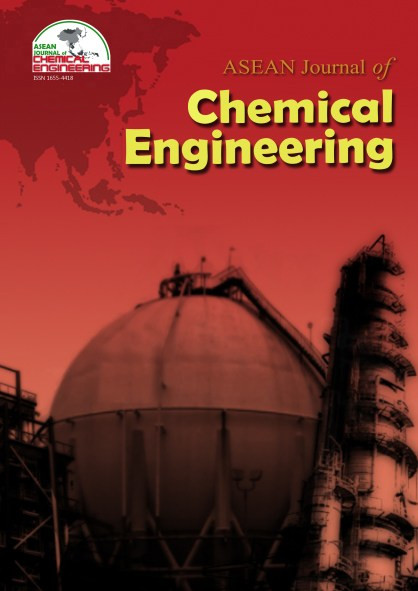Optimization Research into the Ultrasonic-assisted Extraction to Separate Polyphenol from Green Tea Waste
Abstract
Today, green tea leaves (Camellia sinensis) have been grown in nearly 30 provinces in Vietnam. Catechins, which are polyphenols, are abundant in green tea. In a freshly picked tea leaf, polyphenols can compose up to 30% of the dry weight. Recently, researchs have focused on tea polyphenols due to its potent anti-oxidant activity, anti-inflammatory and anti-cancer effects. Viet Nam currently ranks the fifth in the world in tea production and export turn-over. However, green tea is made from the top two leaves and buds of a shrub. A large amount of stems, older leaves and tea wastes from tea factories is not produced. For this reason, study to separation polyphenols from these materials plays an important role in science, society and economy. Polyphenols can be extracted from green tea leaves by using hot water and organic solvents. In the method of using hot water, green tea quality deteriorates and catechins are destroyed due to the heat applied. Therefore, we attempted to increase the amount of polyphenols in extracts with using ultrasonic irradiation at low temperature. This work has an aim to investigate the influent process parameters such as extraction time, stirring speed and the rate of raw material/solvent on efficiency of the extraction of polyphenols and antioxidant properties obtained extracts. The ultrasonic-assisted extraction was conducted at room temperature, ultrasound frequency (25 kHz) using water solvent. Extracts were analysed for total phenols content (TPC) by the Lowenthal method. The antioxidant properties have been determined by DPPH free radical scavenging effect, The results of the work are the basis to determine of the optimal technological factors by employing desirability methodology with experimental order of Box-Behnken design and to scale up for designed industrial extraction system that can be applied in tea plants for the production of tea polyphenols from tea wastes.References
2. Derringer G., Suich R. (1980). Simultaneous optimization of several responses variables, Journal of Quality Technology, 12 (4), pp. 214-219.
3. Gu X., Cai J., Zhang Z., Su Q. (2007). Dynamic Ultrasound-Assisted Extraction of Catechin and Caffeine in Some Tea Samples. Annali di Chimic 97: 321 – 330.
4. Gupta,S.,Saha,B.,Giri,A.K.,2002.Comparative antimutagenic and anticlastogenic
effects of green tea and black tea: a review. Mutation Research 512, 37–65.
5. Hitoshi K., Nobuyoshi M. (2007). Extraction of Catechins from Green Tea Using Ultrasound, Japanese Journal of Applied Physics 46 (7B): 4936 - 4938.
6. Kuroda,Y.,Hara,Y.,1999. Antimutagenic and anticarcinogenic activity of tea polyphenols. Mutation Research 436 (1), 69–97.
7. Moyers,S.B.,Kumar,N.B.,2004. Green tea polyphenols and cancer chemoprevention: multiple mechanisms and endpoints for phase II trials. Nutrition Reviews 62(5), 204–211.
8. Phung Lan Huong, Tran Trung Kien, Nghiem Xuan Son (2009). Dynamic Model Of Ultrasonic-Assisted Extraction – Application For Isolation Of Natural Products. Journal of Science and Technology, Band 47, Nr. 5A, 69-75.
9. Stone, M.H., Fleck, S.J., Kraemer, W.J., Triplett, N.T., 1991. Health and performance related changes adaptations to resistance training. Sports Medicine 11, 210–231.
10. Tura D., Robards K., 2002. Sample handling strategies for the determination of biophenols in food and plants. J. Chromat. A, 975, 71-93.
11. Zhu Q.Y., Hackman R.M., Esunsa J.L., Holt R.R., and Keen C.L., (2002). Antioxidative
activities of Oolong tea, J. Agric. Food Chem., 50 (23), 6929-6934.
Copyright holder for articles is ASEAN Journal of Chemical Engineering. Articles published in ASEAN J. Chem. Eng. are distributed under a Creative Commons Attribution-NonCommercial 4.0 International (CC BY-NC 4.0) license.
Authors agree to transfer all copyright rights in and to the above work to the ASEAN Journal of Chemical Engineering Editorial Board so that the Editorial Board shall have the right to publish the work for non-profit use in any media or form. In return, authors retain: (1) all proprietary rights other than copyright; (2) re-use of all or part of the above paper in their other work; (3) right to reproduce or authorize others to reproduce the above paper for authors’ personal use or for company use if the source and the journal copyright notice is indicated, and if the reproduction is not made for the purpose of sale.


